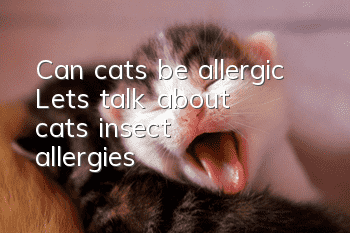Can cats be allergic? Let’s talk about cats’ insect allergies!

Can mites cause cat allergies?
Can cats be allergic? Let’s briefly talk about cat insect allergies! The above mentioned some cat insect allergies caused by mosquitoes and ant bites, among which mosquitoes are the most The important route of heartworm infection requires us to pay attention to it in our lives and take some basic anti-mosquito measures. Of course, there are many more insect infections in cats, let’s take a look below.
3. Mite allergy
1. Scabies mites
This disease is mainly a parasitic disease caused by cat anal mites parasitizing in the cat’s skin. This disease often occurs mainly on the cat's ears, face, eyelids and neck. The affected area suffers from severe itching, hair loss, red skin, rash-like nodules, and yellow scabs on the surface. In severe cases, the skin becomes thickened and cracked. Sometimes the lesion develops secondary bacterial infection and suppuration. The areas most commonly infested by scabies mites are hairless or short-haired areas (ear wings, armpits, limbs, and abdomen). In some cases of infection, weight loss occurs due to persistent itching and inability to rest. Inexplicably, even in animals with extremely strong allergic reactions, very few scabies mites are detected. One study showed that infected animals develop large amounts of antibodies but then return to normal after treatment. Although the incidence is not high, well-groomed and cared for cats will occasionally develop scabies mite infestations. The animals will be itchy but have no clinical symptoms and respond well to scabies treatment.
For cats who are allergic to mites, we can cut off the coat of the affected area and its surroundings in advance, and then soak the scabs to soften them. To remove the scab, you can apply potassium soap, 10% coal tar glycerin solution, coal phenol glycerin or carbolic acid glycerin, etc.; or after the scab softens (12 to 24 hours), wash it with warm fertilizer soap solution, and then use 0.5% dichlormethicone. Insect fluid, scrub the affected area, and repeat the treatment once or twice every 7 days; or apply lime-sulfur mixture to the affected area (160g of quicklime, 240g of sulfur, 360m1 of water. First pour an appropriate amount of water into the quicklime, stir it into a gruel, and then add Mix and stir the sulfur. While heating, gradually add water. After pouring out the water, boil for 1 to 2 hours until it turns amber and becomes clear.); or use benzyl benzoate and apply it to the affected area fully every day or every 3 days; or Apply Conix to the affected area. Griseofulvin has been reported to be used successfully as a systemic treatment.
2. Ear mites
Cat ear mites are caused by ear itch mites and ear scabies mites, and are highly contagious parasitic diseases. Male ear worms are 0.32 to 0.35 mm long, and female worms are 0.43 to 0.48 mm long. It has 4 pairs of legs and is an arthropod with incomplete metamorphosis. Ear itch mites live on the surface of the cat's ear canal skin and do not enter the inner layer of the skin. They have a tough horny epidermis and are highly resistant. It sucks lymph fluid and skin cells and relies on tissue residues and tissue nourishment to survive at 6 to 8°C and air humidity of 8It can survive for more than 2 months under conditions of 5% to 100%. The development process includes four stages: egg, larvae, nymph and adult.
Cats infected with ear mites can develop type 1 allergic reactions. The parasite feeds on epithelial debris and epidermal tissue fluid, irritates the ear canal tissue, and accumulates earwax, blood clots or parasite excretion in the ear canal - giving the earwax its characteristic brown appearance. If animals eat this earwax while eating, it may also trigger an immune response. Clinical signs of infection in cats vary from mere appearance of large amounts of skin debris to severe itching of the ears. Treatment for ear mites in cats has been mentioned in several articles and will not be detailed here.
3. Chiggers
The clinical symptoms of cats infected with chiggers are variable , some animals may not show any signs, but some may develop severe itchy dermatitis. Cats' habitual grooming behavior makes it difficult to find parasites during inspection. Post-infection lesions mostly appear on the dorsal side, presenting as dry, scaly dermatitis. As the disease progresses, the scaliness may become more severe and spread throughout the body.
4. Tick allergy
Ticks are also called ticks, grass crawlers, Dog beans. If you find that your cat has been bitten by a tick, do not remove it yourself and go to the hospital to remove it immediately. The doctor will disinfect the area around the wound, anesthetize the tick on the wound, wait until the tick is completely anesthetized, and then use a twister to easily remove it. When the tick burrows its head into the skin, the hook on the head becomes tighter and tighter. If it is taken out by itself, it is easy to leave the head in the skin and continue to infect. It is extremely troublesome to go to the hospital to get the head removed. If you are bitten by an insect, you cannot kill the insect immediately. You should blow it away or the poison will be greater.
The area where the tick bites and adheres will appear in the form of granulomatous nodules (not necessarily red and swollen), itching and ulcers. At the same time, the area where the tick is attached may also suffer from local ulcers or necrosis; occasionally it may cause itchy foot dermatitis.
Cats infected with ticks can also cause other diseases: for example, the neurotoxins released by ticks can cause paralysis in cats; in addition, ticks are intermediate hosts of a variety of blood parasites and can infect ehrlichiosis or rockworms. Mountain spotted fever, pyrozoon and other blood diseases. Severe cases can cause death of animals.
4. Flea allergy
Probably the most common type of insect allergy . Although its pathogenic mechanism is still not fully determined. Cats can be divided into two groups based on their reaction to fleas. Tolerant animals often harbor large numbers of fleas and do not show clinical symptoms. Data show that cats of this type who are exposed to fleas for a long time do not seem to develop flea allergies, or only develop flea allergies. Mild discomfort occurs. In contrast, animals with flea allergies may experience ongoing allergy symptoms if they are exposed to fleas frequently (every 14 days), as this condition is often associated with a type 4 allergic reaction.
It is speculated from the above information that cats who are exposed to fleas intermittently are only more likely to develop flea allergies than those who are frequently exposed. Studies have shown that if a cat with a flea allergy is left untreated and continues to be exposed to fleas, the cat's allergy symptoms will gradually subside; however, this case is likely to be rare.
Clinical signs are more variable in cats than in dogs. Lesions may range from papules and crusts to hair loss, flaking, and scale formation; the distribution is similar to that in dogs, but also includes the neck. In addition, some more specific symptoms often occur, such as miliary dermatitis, eosinophilic granulomatous syndrome, including painless ulcers, eosinophilic plaques, collagenolytic granulomas, and spontaneous symmetrical hair loss without initial lesions; There are also occasional rashes caused by sterile eosinophilic folliculitis or furunculosis. A combination of the above symptoms may occur in cats.
5. Treatment
Like other allergies, insect allergies can only be controlled . It mainly deals with reducing the chance of animal contact with insects and improving the animal's immune system.
Cats raised indoors or small-sized cats are more likely to be able to control this disease by avoiding contact with allergens, but it is not feasible at all for animals that live partially or all day outdoors. Therefore, effectively removing insects and disinfecting the environment is the best of both worlds. If a cat develops a related allergic reaction after being bitten, epinephrine treatment (0.02mg/kg) should be given as soon as possible. Glucocorticoids modulate immune responses through multiple mechanisms. When animals are diagnosed with allergic reactions, they are often treated with short-acting corticosteroids to suppress allergic symptoms.
- Do cats have to take hair removal cream?
- What should you do if your cat has a fever? What to do if your cat has a cold or fever!
- How to make a cat vomit hairballs? How to prevent hairball disease
- American Wirehair Cat Training Methods
- What color is a British shorthair cat?
- What is the favorite food of exotic shorthair cats? How much do you know about feeding shorthair cats?
- Is it because the hairless cat has diarrhea because there are worms in its stomach? The poop scraper comes in to take a look!
- How many months do you need to start vaccinations for cats?
- Cat urinary system problems, how to prevent and treat them?
- How to take care of your new Garfield cat?



